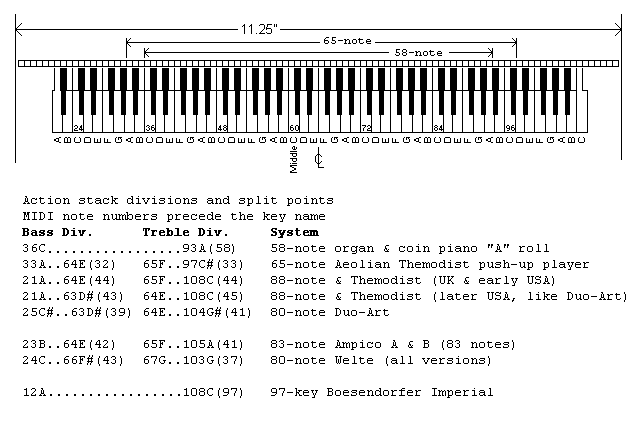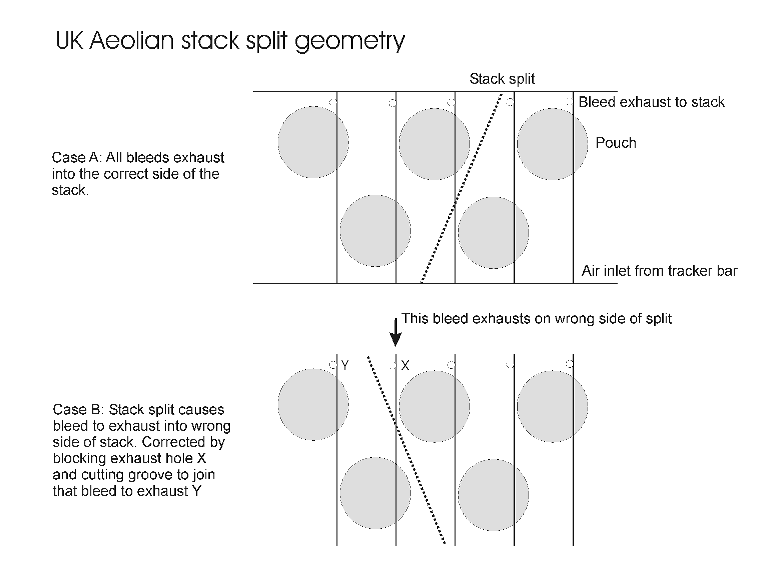| You Are Not Logged In | Login/Get New Account |
|
Please Log In. Accounts are free!
Logged In users are granted additional features including a more current version of the Archives and a simplified process for submitting articles. |
|
MMD
 Tech
Tech
 bass-treble
bass-treble
|
|
Duo-Art Bass/Treble Split Points by Julian Dyer (031105 MMDigest) (expanded), (031118 MMDigest) Aeolian introduced Themodist publically in the UK in November 1907, in 65-note instruments; they hadn't started to make 88-note instruments at that time. The theme holes were added at the ends of the 65-note scale, spaced on the same 6-to-the-inch pattern as all the other holes. It's not obvious from the tracker bar that a 65-note player is themed, because the theme holes are exactly the same size and shape as the note holes. Only the gap from the edge of the roll, or the number of holes, gives it away. Originally, 88-note Themodist pianos were shipped with stacks divided
E/F above middle C, giving 44 notes each side of the split. Hupfeld
88-note rolls have the same split point. Early Aeolian and Hupfeld
rolls have the split printed on the roll to aid Pianolists' use of the
solo control levers. My 1909 65/88 player naturally applies the same
split for 65-note rolls. The 65-note scale omits 12 bass and 11 treble
notes so this gives a 32:33 split.
Duo-Art pianos inexplicably have the split one note lower at D#/E, giving a 43:45 split on the keyboard. The system plays 80 notes, omitting 4 each from bass and treble, giving a working split of 39:41. Later American Themodist instruments appear to have adopted the Duo-Art split at D#/E, presumably because they used the same action stacks. There is some suggestion that later Themodist rolls accent the ambiguous E with snakebites in both treble and bass, a practice that ought to be adopted today when anybody makes accented rolls. Ampico split at E/F, giving a 44:44 keyboard split. The system plays 83 notes, omitting 2 bass and 3 treble notes, giving a working split of 42:41. Welte split at F#/G, giving a 46:42 keyboard split. The system plays 80 notes, omitting 3 bass and 5 treble notes, giving a working split of 43:37. Looking at what technical information I can find, it's notable that none of the literature states stack split points, even when going into great detail about every other aspect of the tracker scale. Now's the chance to fill in details for all those other split-stack systems! Julian Dyer
Duo-Art Bass/Treble Split Points
In MMD 031116, Bernt Damm described his UK Duo-Art stack with a crude channel carved to connect the bleed exhaust channel of the note at the stack split point to the other side of the stack. He assumed this was a factory fault that had been bodged up and fixed it. Actually, this was standard construction, and these stacks should be left exactly as built! The problem arises from the design of Aeolian stack that has two staggered rows of pouches with the bleeds installed in the pouch boards and exhausting into the stack. The stacks with separate bleed rails (as normally found in grand pianos) are not affected because the suction supply to the bleeds is separate from the pouch board. The stack divider runs diagonally across the stack between the pouches. In one direction, this results in all the bleeds exhausting into the same side of the stack as the pouch they operate. However, if the stack split is shifted by one position either way, the divider has to run on the opposite diagonal. Unfortunately, the board layout isn't symmetrical, so reversing the divider results in one of the bleeds next to the split point now exhausting into the opposite half of the stack to its pouch. If this is left uncorrected, the note will be operated merely by the difference in suction levels on either side of the stack. (I've produced a diagram to help visualise this.) The fix adopted at the factory was to block the inappropriate exhaust channel and gouge a new channel along the edge of the pouch board to join up with the adjacent exhaust into the correct side of the stack. It looks a very crude bit of work, and I'm sure numerous rebuilders have "corrected" it then wondered why their instrument doesn't work (if they ever notice). The difficulty faced in the factory was that stacks were designed with a 44:44 or 40:40 split for Themodist instruments, and when so divided all is well. When the Duo-Art coding shifted the split by one note to 39:41, the pouch board design couldn't cope. A redesign that inverted the two rows of pouches would have worked, but then the stack would be wrong for Themodist instruments -- and the factory had to produce both.
The simple fudge of joining the 'wrong' exhaust channels to the correct side of the stack can be seen as a quick and effective shop-floor fix to a problem arising from a ill-considered usage change imposed from on high (anyone working in the software industry today will sympathise). The people who built them weren't idiots and understood what they were doing, even if modern rebuilders don't! So, in this case the original build was functionally correct, if inelegant, and should be left alone. Connecting the bleed exhaust to the wrong side of the stack will give rise to false notes, and modifying the stack split point gives an instrument incapable of correctly playing the rolls it was build for. Julian Dyer
18 November 2003 |
|
|
|
|
|
|
|
|
|
CONTACT FORM: Click HERE to write to the editor, or to post a message about Mechanical Musical Instruments to the MMD Unless otherwise noted, all opinions are those of the individual authors and may not represent those of the editors. Compilation copyright 1995-2026 by Jody Kravitz. Please read our Republication Policy before copying information from or creating links to this web site. Click HERE to contact the webmaster regarding problems with the website. |
|
|
||||||
|

